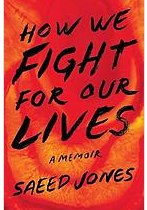Off the Shelf #26
Making Their Mark: The Literature of Tattooing
by Rob Ridinger
An art form frequently seen on (but certainly not limited to) members of the LGBT community, tattoos have been a part of the aesthetics of many cultures for millennia. In this column I sample a diverse body of literature on tattooing published in the last two centuries to provide perspective for both the researcher and the general reader looking for background on possibly acquiring ink.
While the practice of adding lasting designs to the human skin has existed for centuries, the English word for it dates to the eighteenth-century European voyages of discovery in the Pacific Ocean. According to the Oxford English Dictionary, “tattoo” makes its first appearance in the expedition logs of Bougainville and Cook, who both noted variants of the Polynesian word tatau, meaning to stamp or mark, which referred to the adornments they observed on the inhabitants of these island groups. (Both French and English spellings in use today are derived from Polynesian languages.)
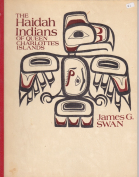 Since tattooing had been shunned—though not officially outlawed—in most of Christian Europe since late Antiquity, Western tattoo research did not appear in earnest until the nineteenth century, as part of the newly-created discipline of anthropology. Fieldwork across the globe resulted in a diverse body of scholarship ,that discussed the art of permanent body marking. (An early example of this literature is James G. Swan’s The Haidah Indians of the Queen Charlotte’s Islands, British Columbia,: with a brief description of their carvings, tattoo designs, etc., published in 1874 by the Smithsonian Institution; others covered (Japan, Samoa, the Marquesas islands, Hawaii, and even Morocco; as well as the Inuit, the Maori of New Zealand), and the Cree.).
Since tattooing had been shunned—though not officially outlawed—in most of Christian Europe since late Antiquity, Western tattoo research did not appear in earnest until the nineteenth century, as part of the newly-created discipline of anthropology. Fieldwork across the globe resulted in a diverse body of scholarship ,that discussed the art of permanent body marking. (An early example of this literature is James G. Swan’s The Haidah Indians of the Queen Charlotte’s Islands, British Columbia,: with a brief description of their carvings, tattoo designs, etc., published in 1874 by the Smithsonian Institution; others covered (Japan, Samoa, the Marquesas islands, Hawaii, and even Morocco; as well as the Inuit, the Maori of New Zealand), and the Cree.).
In the United States, “dime novels,” also influenced popular ideas about tattoos e.g. the spectacularly titled Facts relating to Miss Irene Woodward, the only tattooed lady: being a full and complete account of the life and adventures of this young lady, the only tattooed female in the world: together with many extracts from the metropolitan press in reference to her, all clearly proving her to be one of the most remarkable and rarest curiosities now on exhibition or The true life and adventures of Captain Costentenus, the tattooed Greek prince by Djordgi Konstantinus, both published in the 1880s.
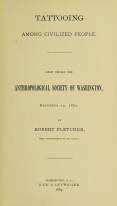 Both cheaply available works such as these, and serious scholarship, introduced the idea of tattooed people as outside the usual American social classes to the popular imagination of the United States. In a 1882 paper Tattooing among civilized people given at the Anthropological Society of Washington, for example, Robert Fletcher neatly summarized the prevailing attitude at the end of the nineteenth century:
Both cheaply available works such as these, and serious scholarship, introduced the idea of tattooed people as outside the usual American social classes to the popular imagination of the United States. In a 1882 paper Tattooing among civilized people given at the Anthropological Society of Washington, for example, Robert Fletcher neatly summarized the prevailing attitude at the end of the nineteenth century:
Where large bodies of men are thrown together, with much idle time, it is among them that we should expect to find a custom like tattooing most prevalent. Accordingly, it is soldiers, sailors, and, above all, criminals, including prostitutes, who most extensively resort to it.
As regards soldiers and sailors, the love of imitation and a desire to emulate the adornment of their veteran comrades are doubtless the chief motives for the practice. The designs most in vogue with them are such as relate to the glories of their profession, and flags, cannon, ships, patriotic symbols, and amorous devices form the stock in trade of the artist in the barracks or on shipboard.
The criminal classes furnish the most elaborate and the most curious examples of tattooing. Of late years the study of the criminal from a psychological point of view has been pursued with remarkable results by certain observers.” (Fletcher 1883:8)
In 1896, the striking tattoo arts of New Zealand received a lengthy illustrated treatment in Moko, or Maori Tattooing, written by Horatio Robley, a veteran of the Tauranga Campaign of 1864-1866. Moko or whakairo were the Maori terms for the complex designs applied to the face and body of both men and women, whose art is examined in separate chapters. Other subjects explored are the processes of making moko and the customs associated with them, how moko became known to Europeans (beginning with Captain Cook’s 1769 visit to New Zealand), the social position of moko artists, non-Maori who had acquired notable works of moko, and a lengthy discussion of the traditional practice of preserving the heads of warriors, kinsmen and deceased friends, specimens of which were some of the first examples of moko to be obtained by museums outside New Zealand.
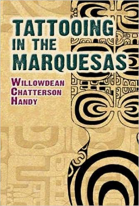 In 1922, the Bishop Museum in Honolulu issued a short publication by Willowdean Chatterson Handy on Tattooing in the Marquesas, which aimed to document a cultural practice on the verge of disappearance. Handy notes that,
In 1922, the Bishop Museum in Honolulu issued a short publication by Willowdean Chatterson Handy on Tattooing in the Marquesas, which aimed to document a cultural practice on the verge of disappearance. Handy notes that,
[a]s tattooing is now forbidden by the [French colonial] laws of the country and the art is consequently dying out, this collection of the last specimens of tattooing patterns which exits today in the Marquesas has seemed to demand a complementary collection of information regarding the practice of the art, to the end that the beautiful motives might at least be partly accounted for and might some day take their merited place in the history of art. (Handy 1922: 3)
The volume opens with an essay on Marquesan traditions of tattooing before the French banned the practice in 1884, the substances and techniques used by the artists, and the legal restrictions which by 1922 had left only 125 people as living examples of the art. The second section, “The Design,” discusses historical references to Marquesan tattooing in travelers’ and explorers’ accounts since 1790, the combination of naturalistic and geometric motifs (and the parts of the body which were adorned by them), and the use of bands of tattoos. The rest of the publication contains a glossary of translations of the design names, a short bibliography on Marquesan tattooing, and descriptions for the thirty-eight plates illustrating face, hand, and body patterns that complete the work.
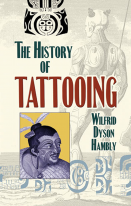 Three years later, anthropologist Wilfrid Hambly’s lengthy book The History of Tattooing and Its Significance, with some account of other forms of corporal marking was published in London. His approach to the subject comes from within his discipline, as he notes that many previous writers on tattooing have not done so within the framework of studying the matrix of cultural rituals, ceremonies and beliefs within which tattoos are created and applied. His interest in tattooing began when he participated in the Wellcome Expedition to the Sudan from 1910 to 1914. Readers of his book will be reminded of the views about tattooing expressed in Robert Fletcher’s 1882 paper given in Washington, D.C., but Hambly’s focus is to set tattooing as represented worldwide within questions relating to the migration of cultures by examining common uses made of it. The first three chapters cover “Body Marking in Relation to Religious Beliefs and Practices,” “Body Marking and Magic,” and “Body Marking for Social and Antisocial Purposes.” Chapters four and five (the shortest in the entire book) detail “Techniques of Body Marking” and the “Geographical Distribution of Tattooing,” this latter divided up into Europe, Asia, the Pacific, Africa, and the American Continents. The final chapter on the “Historical Distribution of Tattooing” provides an interesting summary of both then-contemporary knowledge of evidence for tattooing across the centuries from prehistoric times (mainly the use of red ocher through the civilizations of Sumer, Babylon, China, Japan, the Pacific Islands, Mexico, the Maya, Peru, and Egypt) and hypotheses about the origin and spread of specific techniques worldwide.
Three years later, anthropologist Wilfrid Hambly’s lengthy book The History of Tattooing and Its Significance, with some account of other forms of corporal marking was published in London. His approach to the subject comes from within his discipline, as he notes that many previous writers on tattooing have not done so within the framework of studying the matrix of cultural rituals, ceremonies and beliefs within which tattoos are created and applied. His interest in tattooing began when he participated in the Wellcome Expedition to the Sudan from 1910 to 1914. Readers of his book will be reminded of the views about tattooing expressed in Robert Fletcher’s 1882 paper given in Washington, D.C., but Hambly’s focus is to set tattooing as represented worldwide within questions relating to the migration of cultures by examining common uses made of it. The first three chapters cover “Body Marking in Relation to Religious Beliefs and Practices,” “Body Marking and Magic,” and “Body Marking for Social and Antisocial Purposes.” Chapters four and five (the shortest in the entire book) detail “Techniques of Body Marking” and the “Geographical Distribution of Tattooing,” this latter divided up into Europe, Asia, the Pacific, Africa, and the American Continents. The final chapter on the “Historical Distribution of Tattooing” provides an interesting summary of both then-contemporary knowledge of evidence for tattooing across the centuries from prehistoric times (mainly the use of red ocher through the civilizations of Sumer, Babylon, China, Japan, the Pacific Islands, Mexico, the Maya, Peru, and Egypt) and hypotheses about the origin and spread of specific techniques worldwide.
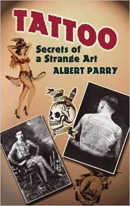 In 1933, Albert Parry published Tattoo: secrets of a strange art as practised among the natives of the United States, which he hoped to be “a pioneer study, opening the way for further volumes by other researchers.” (Parry 1933: xi). He begins by examining the uses made of tattoos by specific segments of the population—women and men, the varied ways they were used among prostitutes, and the reasons why young people would be drawn to getting tattooed.
In 1933, Albert Parry published Tattoo: secrets of a strange art as practised among the natives of the United States, which he hoped to be “a pioneer study, opening the way for further volumes by other researchers.” (Parry 1933: xi). He begins by examining the uses made of tattoos by specific segments of the population—women and men, the varied ways they were used among prostitutes, and the reasons why young people would be drawn to getting tattooed.
Parry then draws a detailed picture of different motifs and designs in the arsenal of American tattooists in the early 1930s. He notes that the history of religious imagery in tattoos may date to early Christian England and the pilgrims to the Holy Land who sometimes had themselves marked with holy symbols. He ascribes the introduction of ornate plant and animal designs to the American tattoo market in part to the significant influence of one of P.T. Barnum’s stars, the heavily marked Captain Georgius Constantine, whose entire body surface was covered in deep designs he had obtained in Burma. Sailors returning from the Orient with elaborate designs drawn from Chinese or Japanese art added further to the pool of design elements. The latter were expanded by English tattooists who focused on replicating the intricacies of the original art forms such as dragons and peacocks, but “since the 1890s they have been bitterly complaining that the Oriental style is being ruined by the rough work of the American tattooers.” (Parry 1933: 40-41.)
Parry regards tattoos conveying the themes of patriotism and love as “of uniquely American origin,” beginning with their use in the eighteenth century as a means of identification in case of drowning and enriched by the imagery of each successive conflict, with the Civil War seeing designs supporting the Union cause, the Spanish-American War the introduction of steam-powered battleships replacing traditional sailing ships, and World War I adding airplanes. American popular culture’s influence on tattooing imagery is seen in the use of then-familiar comic strip characters such as the Katzenjammer Kids and Felix the Cat, while slang terms sometimes found more permanent expression on a bicep or other body part, an example being the phrase “So’s your old man.” By 1933, the impact of the movie industry was also clearly visible, with depictions of favorite actresses and actors becoming standard orders. As Parry wryly notes, “the latest wrinkles are Marlene Dietrich and Mickey Mouse. Mickey, having become a folk character, will probably outlast Marlene.” (Ibid.: 41.)
After reviewing the history of known American tattoo masters, beginning with Martin Hildebrandt in 1870, and noting the introduction of electric needle technology to tattooing in the late nineteenth century, Parry highlights the role of curiosity shows and the circus in popularizing tattoos.,He notes that “the idea of exhibiting white tattooed men for a fee was born among European visitors to the South Sea Islands and was first tried out in western Europe” (Parry 1933: 58), beginning with Joseph Cabri in the eighteenth century. The idea was imported to the United States in the 1850s but most elaborately brought to public attention by P.T.Barnum. His success inspired other circus owners to add tattooed people to the arrays of the unusual, including many women. Parry explores in detail not only how and when women entered the tattoo spotlight in the 1880s (becoming a stronger draw for the public than their male counterparts) but the diversification of the tattooed population among American circuses to include dwarves and Native Americans.
The penchant among sailors to get inked is explored in the seventh chapter, while the eighth, on “Low Herd-High Society,” addresses tattooing among the upper classes and the reasons for its popularity as a fad at various points in American history beginning in the 1880s. Chapter eight covers the uses made of tattoos for the purpose of “Identification,” ranging from colonial sailors through the Roger Tichbourne court case in the 1870s in England (where the absence of known tattoos helped expose a claimant to an estate as a fake) to the then-recent spate of having children and infants tattooed which followed the Lindbergh kidnapping in 1932. A more familiar use of tattooing as protection is reviewed in chapter nine, “Faith, Magic and Disease.” Unique among the books published on tattooing up the 1930s is the extensive final chapter on “Removal,” as much of the literature on the mechanics of being marked is devoted rather to the instruments and techniques used to construct images on the body than to ways of removing them. Processes noted involve chemicals, surgery, electrolysis, excision and dry ice.
Perhaps the most vivid depiction of the attitudes towards tattooing in the United States prior to World War II can be found in the score for the 1939 Marx Brothers film At the Circus. In a scene with other circus performers, Groucho Marx fondly reminisces about the love of his life, a fellow circus star known as Lydia the Tattooed Lady. In this lengthy and extremely funny song by Harold Arlen, he catalogs for his listeners the many designs that Lydia has had applied to her body. Some are topical for 1939 (an example is the Trylon, one of the two major symbolic structures that composed the logo of the 1939 World’s Fair in New York City) while others include notable figures from history such as Lady Godiva and Andrew Jackson and even Niagara Falls and the Amazon The humorous overtones of the song cast people who wore tattoos as exotic figures not to be taken quite seriously.
After World War II, one of the first books on tattooing for the general public was Hanns Ebensten’s Pierced Hearts and True Love; an illustrated history of the origin and development of European tattooing and a survey of its present state, published in London in 1953. Its focus on European tattooing supplements Hambly’s 1933 book, and chapters are included on the state of tattooing in Britain at the time of publication, cosmetic and magical uses of tattoos, their role as art, and a brief discussion of the variety of impulses that can lead someone to want to be inked.
In 1955, the World Folk Arts series brought out the short volume Tattooed Women and their Mates authored by Hal Zucker. Over half of the work is taken up by black and white photographs illustrating the range of possible types of tattoos ranging from familiar forms used by sailors and soldiers (including a member of the Foreign Legion who sported a tattooed mustache) to unique shapes and slogans based on individual choice.
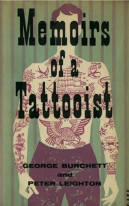 The stream of publishing on British tattooing begun by Hambly and Ebensten continued with the appearance in 1958 in London of a posthumous personal account of life and career by one of England’s veteran skin artists, Memoirs of a tattooist, from the notes, diaries, and letters of the late “King of Tattooists,” George Burchett. He traces his interest in tattoos from the sailors he knew as a boy in Brighton (and childhood efforts at marking up his schoolmates) to his enlistment in the Royal Navy in 1885 at age thirteen, his meeting with the Japanese tattoo master Hori Chyo in Yokohama, and the themes and fads in tattooing taken up by the British public from The Victorian Era to World War II and the coronation of Queen Elizabeth II (and includes some notable clientele). Much of the text discusses various techniques of tattoo creation and explores accepted ideas about their usage by different social groups through data from Burchett’s lengthy experience. It should be noted that while the history of tattooing in the nineteenth and twentieth centuries makes mention of prominent artists active in venues as widely separated as Japan, Europe and the United States, few of them left any lengthy memoirs comparable to Burchett’s. It foreshadows the 1990 book by American tattooist Samuel Steward, Bad Boys and Tough Tattoos: A social history of the tattoo with gangs, sailors, and street-corner punks, 1950-1965, and Justin Spring’s 2010 biography of him, Secret Historian: The life and times of Samuel Steward, professor, tattoo artist, and sexual renegade.
The stream of publishing on British tattooing begun by Hambly and Ebensten continued with the appearance in 1958 in London of a posthumous personal account of life and career by one of England’s veteran skin artists, Memoirs of a tattooist, from the notes, diaries, and letters of the late “King of Tattooists,” George Burchett. He traces his interest in tattoos from the sailors he knew as a boy in Brighton (and childhood efforts at marking up his schoolmates) to his enlistment in the Royal Navy in 1885 at age thirteen, his meeting with the Japanese tattoo master Hori Chyo in Yokohama, and the themes and fads in tattooing taken up by the British public from The Victorian Era to World War II and the coronation of Queen Elizabeth II (and includes some notable clientele). Much of the text discusses various techniques of tattoo creation and explores accepted ideas about their usage by different social groups through data from Burchett’s lengthy experience. It should be noted that while the history of tattooing in the nineteenth and twentieth centuries makes mention of prominent artists active in venues as widely separated as Japan, Europe and the United States, few of them left any lengthy memoirs comparable to Burchett’s. It foreshadows the 1990 book by American tattooist Samuel Steward, Bad Boys and Tough Tattoos: A social history of the tattoo with gangs, sailors, and street-corner punks, 1950-1965, and Justin Spring’s 2010 biography of him, Secret Historian: The life and times of Samuel Steward, professor, tattoo artist, and sexual renegade.
Robert Sparks’ 1965 master’s thesis at the University of Hawaii, Polynesian Tattooing: the techniques, iconography, patronage, profession, and esthetics also reviews tattooing as a cultural practice within Pacific Ocean societies. The intricate designs created by the hori masters of Japan are showcased in a small book produced in Tokyo in 1966 by the Zufu Shinsa publishing house. Jointly shaped by photographer Ichira Morita and Donald Richie, Irezumi was the first photo book devoted to Japanese tattooing and, although issued in a limited edition, remains a valuable resource for this genre of tattooing history.
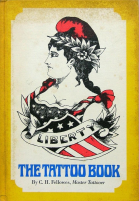 References to the collections of designs available to be perused by prospective clients of tattoo artists are frequent in the literature, although the work of most tattooists (when it can be identified) is usually assessed through examining individual examples, visually recorded in formats ranging from line drawings to color photographs. An exception to this is the subject of the 1971 publication The Tattoo Book, by C.H. Fellowes, Master Tattooer. Its history begins in 1966, when a Providence Rhode Island antique dealer discovered a sketchbook of tattoo designs and a hand tattooing kit which had been sold to a private collector. No documentation on Fellowes and his career was found in a search of newspapers and city directories in New England, making it likely he was not based in one place but traveled seeking clients in both the Navy and possibly in the circus world. The book reproduces Fellowes’ sketchbook in full and offers a unique historical glimpse into patriotic, religious, and romantic images.
References to the collections of designs available to be perused by prospective clients of tattoo artists are frequent in the literature, although the work of most tattooists (when it can be identified) is usually assessed through examining individual examples, visually recorded in formats ranging from line drawings to color photographs. An exception to this is the subject of the 1971 publication The Tattoo Book, by C.H. Fellowes, Master Tattooer. Its history begins in 1966, when a Providence Rhode Island antique dealer discovered a sketchbook of tattoo designs and a hand tattooing kit which had been sold to a private collector. No documentation on Fellowes and his career was found in a search of newspapers and city directories in New England, making it likely he was not based in one place but traveled seeking clients in both the Navy and possibly in the circus world. The book reproduces Fellowes’ sketchbook in full and offers a unique historical glimpse into patriotic, religious, and romantic images.
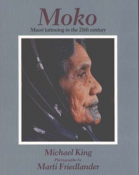 In 1972, Alister Taylor published Michael King’s striking Moko: Maori Tattooing in the 20th Century. This is one of the most significant works on the Maori tattoo traditions of New Zealand. Based upon three years of travel and interviews with 70 elderly Maori women who had received the moko tattoo on their chin and lips, much of the book is black and white and color photographs, and chapters which present the historical background and cultural significance of moko, including the techniques of chisel and needle tattooing, and the patterns conventionally used as the vocabulary of moko designs.
In 1972, Alister Taylor published Michael King’s striking Moko: Maori Tattooing in the 20th Century. This is one of the most significant works on the Maori tattoo traditions of New Zealand. Based upon three years of travel and interviews with 70 elderly Maori women who had received the moko tattoo on their chin and lips, much of the book is black and white and color photographs, and chapters which present the historical background and cultural significance of moko, including the techniques of chisel and needle tattooing, and the patterns conventionally used as the vocabulary of moko designs.
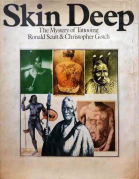 Two years after Moko, a heavily illustrated book appeared that explored the subject of tattooing for the general reader in a manner akin to Albert Parry’s 1933 work. Skin Deep: The Mystery of Tattooing was written by a dermatologist serving in the Royal Navy (who drew upon data recorded from several hundred sailors and their tattoos) and a journalist with interests in tattoo art. The opening chapter covers motives for being tattooed and changes in technical aspects. Other chapters examine a range of topics including the history of tattoos as then known from ancient times though the nineteenth century (with note taken of Maori full-face designs), Japanese artists and their impact on stimulating the industry in the West, sexual and criminal associations, and tattooing as an art form. Two appendices present data on the state of tattooing in selected countries and regions worldwide, and offer a listing of significant tattooists from Japan, England, Canada, the Netherlands, New Zealand, Denmark. Hong Kong and Thailand from the nineteenth century to modern times. The popularity of tattooing is reflected In the authors’ comment that ‘Skin deep it may be, but mind deep it certainly is.” (Skin Deep: 20)
Two years after Moko, a heavily illustrated book appeared that explored the subject of tattooing for the general reader in a manner akin to Albert Parry’s 1933 work. Skin Deep: The Mystery of Tattooing was written by a dermatologist serving in the Royal Navy (who drew upon data recorded from several hundred sailors and their tattoos) and a journalist with interests in tattoo art. The opening chapter covers motives for being tattooed and changes in technical aspects. Other chapters examine a range of topics including the history of tattoos as then known from ancient times though the nineteenth century (with note taken of Maori full-face designs), Japanese artists and their impact on stimulating the industry in the West, sexual and criminal associations, and tattooing as an art form. Two appendices present data on the state of tattooing in selected countries and regions worldwide, and offer a listing of significant tattooists from Japan, England, Canada, the Netherlands, New Zealand, Denmark. Hong Kong and Thailand from the nineteenth century to modern times. The popularity of tattooing is reflected In the authors’ comment that ‘Skin deep it may be, but mind deep it certainly is.” (Skin Deep: 20)
The 1980s saw the continuation of scholarship on the Maori tattoo traditions. D.R. Simmons, an ethnologist with the Auckland Museum, authored the detailed 1986 study Ta Moko: The art of Maori tattoo. It begins with a review of the types of ornamentation applied to men (including the techniques of marking the skin, and specific tattoos set on the face, thigh, back and lower leg) and the familiar moko designs worn by women. The second chapter covers male tattooing in the late eighteenth century as documented by the voyages of James Cook and other European travelers, while the third looks at the fashion of male moko during the first half of the nineteenth century. Its reportage is balanced by the fourth chapter covering female moko tattooing, and the final section which examines the roles played by moko and whakairo in Maori society. A unique resource presented by Ta Moko is a translation by Simmons of the only existing account of the tattoo process written in Maori by te Ramgihakeke of Rotorua some time before 1854, describing each step in the tattooing of a Maori leader and the technical details of each stage of the operation.
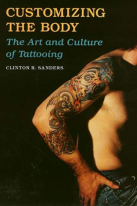 Simmons’ ethnological approach was balanced by the treatment given tattooing in the other major work to appear in the 1980s, sociologist Clinton R. Sanders’ 1989 volume, Customizing the Body: The Art and Culture of Tattooing. Initially introduced to tattooing through a project on body alteration with piercings, Sanders begins with a detailed and readable survey of the known history of body marking, noting the expansion of interest in the practice in late-nineteenth century Europe, sparked by Cook’s voyages (and the exhibition of heavily tattooed people as a social curiosity) and its changing social status, then notes the efforts being made by contemporary tattooists to redefine the craft as a form of fine art . The second chapter, “Becoming and Being A Tattooed Person,” formally explores the social factors which lead someone to decide to acquire ink, considering it as “a normal, symbolically meaningful form of permanent body alteration in contemporary society.” (Sanders 1989: 40-41.) This is followed up by a lengthy chapter dealing with how and why being a tattooist is chosen as an occupation, how the basic skills are learned (with contact with someone already working in the field noted as a key factor), how equipment is obtained, and the types of apprenticeships a novice tattooist may go through, social skills needed for success, and the varied rewards of this career path. Balancing this is the next chapter on “The Tattoo Relationship,“ whose text begins by approaching the in-shop experiences of the client using the concept of perceived risk from consumer research, then moves to examine the factors tattooists use to determine the type of each patron so as to gauge potential problems and conflicts. The final chapter notes that, “the boundaries of the contemporary tattoo production world rub against those of the larger, conventionally legitimated art world. Key actors in the former are increasingly engaged in concerted efforts to broach these boundaries, thereby achieving the valued redefinition of tattooing as art.” (Sanders 1989:150) Elements of tattoo practice affecting the success of this process of redefinition include the uniqueness of the design chosen, links to recognizable cultural and/or historical contexts, materials and procedures employed in the creation of the image, scholarly interest in the art form, and the social status of those who claim and wear tattoos. In his conclusion, Sanders cautions that, ”the central issue to be confronted by key members of the tattoo community is whether the advantages that originate from producing and consuming yet another mode of establishment cultural capital outweigh the intense pleasures of exclusionary identification with the deviant social group symbolized by the tattoo mark.” (Sanders 1989: 163)
Simmons’ ethnological approach was balanced by the treatment given tattooing in the other major work to appear in the 1980s, sociologist Clinton R. Sanders’ 1989 volume, Customizing the Body: The Art and Culture of Tattooing. Initially introduced to tattooing through a project on body alteration with piercings, Sanders begins with a detailed and readable survey of the known history of body marking, noting the expansion of interest in the practice in late-nineteenth century Europe, sparked by Cook’s voyages (and the exhibition of heavily tattooed people as a social curiosity) and its changing social status, then notes the efforts being made by contemporary tattooists to redefine the craft as a form of fine art . The second chapter, “Becoming and Being A Tattooed Person,” formally explores the social factors which lead someone to decide to acquire ink, considering it as “a normal, symbolically meaningful form of permanent body alteration in contemporary society.” (Sanders 1989: 40-41.) This is followed up by a lengthy chapter dealing with how and why being a tattooist is chosen as an occupation, how the basic skills are learned (with contact with someone already working in the field noted as a key factor), how equipment is obtained, and the types of apprenticeships a novice tattooist may go through, social skills needed for success, and the varied rewards of this career path. Balancing this is the next chapter on “The Tattoo Relationship,“ whose text begins by approaching the in-shop experiences of the client using the concept of perceived risk from consumer research, then moves to examine the factors tattooists use to determine the type of each patron so as to gauge potential problems and conflicts. The final chapter notes that, “the boundaries of the contemporary tattoo production world rub against those of the larger, conventionally legitimated art world. Key actors in the former are increasingly engaged in concerted efforts to broach these boundaries, thereby achieving the valued redefinition of tattooing as art.” (Sanders 1989:150) Elements of tattoo practice affecting the success of this process of redefinition include the uniqueness of the design chosen, links to recognizable cultural and/or historical contexts, materials and procedures employed in the creation of the image, scholarly interest in the art form, and the social status of those who claim and wear tattoos. In his conclusion, Sanders cautions that, ”the central issue to be confronted by key members of the tattoo community is whether the advantages that originate from producing and consuming yet another mode of establishment cultural capital outweigh the intense pleasures of exclusionary identification with the deviant social group symbolized by the tattoo mark.” (Sanders 1989: 163)
The 1980s also witnessed the beginning of the periodical Tattootime, founded by Don Ed Hardy. Each issue had a different theme. Tattootime produced five issues by the end of the decade.
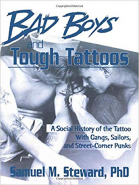 In the 1990s, two works on tattooing appeared, each with a distinctive take on the subject. The first was Samuel M. Stewart’s Bad boys and tough tattoos: a social history of the tattoo with gangs, sailors, and street-corner punks, 1950-1965. Steward was an academic who left that world in the 1950s to take up the profession of tattooist. Stewart was approached by Dr. Alfred Kinsey, who suggested that he “ keep a daily journal to see what might be learned about the sexual motivations for getting tattooed.” (Steward 1990: 3) Taking Kinsey’s advice, Stewart began a record which eventually reached several volumes and was deposited at the Kinsey Institute at Indiana University. The record reflected “the chaos of life as it was observed on the skid row of South State Street in Chicago.” (Ibid.: 5) Topics explored include Steward’s evolution as a tattooist and his varied populations of clients, motivations for getting a tattoo, the folklore of tattooing, and speculations on its future in America. Bad Boys’ extensive use of quotations from Steward’s patrons recalls George Burchett’s accounts of his varied London clientele, and foreshadowed the group of life accounts by practicing tattooist which would appear in the early 21st century.
In the 1990s, two works on tattooing appeared, each with a distinctive take on the subject. The first was Samuel M. Stewart’s Bad boys and tough tattoos: a social history of the tattoo with gangs, sailors, and street-corner punks, 1950-1965. Steward was an academic who left that world in the 1950s to take up the profession of tattooist. Stewart was approached by Dr. Alfred Kinsey, who suggested that he “ keep a daily journal to see what might be learned about the sexual motivations for getting tattooed.” (Steward 1990: 3) Taking Kinsey’s advice, Stewart began a record which eventually reached several volumes and was deposited at the Kinsey Institute at Indiana University. The record reflected “the chaos of life as it was observed on the skid row of South State Street in Chicago.” (Ibid.: 5) Topics explored include Steward’s evolution as a tattooist and his varied populations of clients, motivations for getting a tattoo, the folklore of tattooing, and speculations on its future in America. Bad Boys’ extensive use of quotations from Steward’s patrons recalls George Burchett’s accounts of his varied London clientele, and foreshadowed the group of life accounts by practicing tattooist which would appear in the early 21st century.
The second was Jean-Chris Miller’s encyclopedic work The Body Art Book (1997). Its subtitle clarifies the scope of the coverage as “a complete illustrated guide to tattoos, piercings, other body modifications.” The sections of this work that are relevant to tattooing are the lengthy glossary of terms Learning the Language (containing data on tattoo symbolism and major styles such as Celtic, Oriental, and Haida) and the International Directory of Body Art citing shops, museums, archives and organizations from twenty-five countries. Entries indicate whether the establishment does tattooing, piercing, or both and is aimed at a popular audience unfamiliar with the subjects.
The 1990s also saw the founding of the periodical International Tattoo Art by Jonathan Shaw in New York City—it appeared as a bimonthly from 1992 until at least July 2003.
In 1994, another autobiography was added to the genre of personal histories of tattooists begun by George Burchett and Samuel Steward. In contrast to its predecessors, Sailor Jerry Collins: American Tattoo Master was heavily illustrated with both black and white and striking color photographs of original tattoos and intricate body art created by Collins (1911-1973) during his decades of business in Honolulu. This book is a chronological presentation of a lengthy and detailed group of letters illustrating his participation in and philosophies of tattooing spanning the period 1969 to 1973, and ending with a letter written the day before his fatal heart attack on June 12, 1973. The book features a preface by tattooist Don Ed Hardy, later profiled in the 2010 documentary film Ed Hardy: Tattoo the World. In 2013 Hardy would write his own account of his career, Wear Your Dreams: My Life in Tattoos. The Collins volume was reprinted in 2005 and 2007.
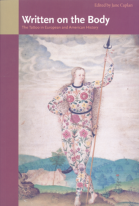 The new century opened with two new works on tattooing. The first was a collection of fourteen essays, Written on the Body: The tattoo in European and American history, edited by Jane Caplan. The preface to this collection makes a notable observation about the cultural place of tattooing within the European past:
The new century opened with two new works on tattooing. The first was a collection of fourteen essays, Written on the Body: The tattoo in European and American history, edited by Jane Caplan. The preface to this collection makes a notable observation about the cultural place of tattooing within the European past:
The tattoo is made apparent in the archaeological and written record between historic times and some point in the early Middle Ages. It then becomes virtually invisible for several hundred years before re-entering the field of vision in the eighteenth century. One should not read this long gap simply as a defect in the historical record…it is also…emblematic of the nomadic and contested status of the European tattoo itself, its character of always being in transit from or to the multiple horizons of a self-centred world…circulating most actively on the margins where it is least visible…typically represented in official discourse as something that has arrived from somewhere else-from another culture, another country, another epoch. (Caplan 2000: xv)
Topics explored include the place of the tattoo in the late Roman Empire, as practiced by the Celtic peoples of Ireland and Great Britain, seventeenth century England, Victorian Britain, national tattoo preferences uncovered during criminological research in the 1880s among convict populations in India, Russia, and Australia, and as part of the entertainment world. American readers will find Alan Govenar’s essay on “The Changing Image of Tattooing in American Culture, 1846-1966” useful as a bridge to the contemporary tattoo scene.
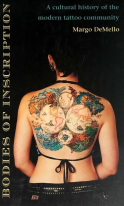 The academic overview of tattoo history provided in Written on The Body was balanced by the personal voice of anthropologist Marge DeMello in the second work published in 2000, Bodies of inscription: a cultural history of the modern tattoo community. “Modern” as used here focuses on how the contemporary tattoo world has grown and changed. DeMello writes in the classic ethnographic mode of a participant observer, as someone who has acquired designs and is married to a tattooist. In the introduction, she frames her research for the reader:
The academic overview of tattoo history provided in Written on The Body was balanced by the personal voice of anthropologist Marge DeMello in the second work published in 2000, Bodies of inscription: a cultural history of the modern tattoo community. “Modern” as used here focuses on how the contemporary tattoo world has grown and changed. DeMello writes in the classic ethnographic mode of a participant observer, as someone who has acquired designs and is married to a tattooist. In the introduction, she frames her research for the reader:
This book is about the emergence of tattooing, since the 1980s, as a new cultural, artistic, and social form, and it is also about the diverse community of people who have come to embrace it. Since its arrival in the United States, the tattoo has shifted back and forth between the upper and lower classes, and…has also shifted in meaning. In each stage of its artistic and social evolution, the tattoo itself has been refined, moving from the mark of the primitive to a symbol of the explorer, a sign of patriotism and a mark of rebellion, to where it stands for many today, as a sign of status. In this ethnography, I explore the current middle-class repackaging of the tattoo, a process that highlights the tattoo’s “primitive“ exotic roots and at the same time seeks to erase its white, working-class beginnings in this country.” (DeMello 2000: 3.)
Beginning with the various settings where the idea of a tattoo community is expressed (tattoo magazines, conventions of both tattoo artists and people proud to share their designs, and the Internet), the discussion moves to examining tattooing as done in the West and “the context in which tattooing entered the Western imagination.” (DeMello 2000: 15.) The history opens in 1846 with Martin Hildebrandt of New York City, and notes the impact of Samuel Reilly’s 1891 creation of the electric tattoo machine,the (chiefly military) clientele seeking to be tattooed, and how exhibiting tattooed persons in circuses and carnivals, “relied on the continuing association between tattooing and savagery in order to sell tickets.” (Ibid.: 53) With the end of World War II popularity of tattooing declined as the American cultural focus shifted from military concerns to middle class life. While traditional tattoo artists remained active, the public perception of tattoos became more negative with the development of a new visibility for bikers, convicts and gang members who continued to adapt tattooing to their specific needs. The association of tattoos with specific socially marginal groups laid the groundwork for the later adoption of tattoos by the hippie counterculture in the late 1960s. This fragmented the older tattoo corpus of designs into varied visual menus carrying more focused meanings. The third chapter covers the “Tattoo Renaissance” in the 1970s which saw the counterculture wearing tattoos as a continuance of the defiant claiming of identity begun in the postwar era, and the addition of exotic imagery in the work of younger tattoo artists, drawing on cultures as varied as Samoa, Borneo, and Native America. Chapters four through seven explore the impact of media representations of tattooing, the rise of tattoo magazines and organizations aimed at making the practice less tied to its working-class past, the shifts in the meaning of tattoos within a middle-class context, and the future of the new community.
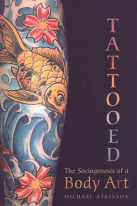 In 2003, a Canadian voice was added to the body of tattoo literature. In Tattooed: the sociogenesis of a body art, Michael Atkinson presents research based on his ten years of interactions with the tattoo community of Canada using the analytic framework of figurational sociology. He uses this theoretical approach to look at “how social life is … conceived of as a grid of interrelated actions … how individual lives are tied to others … an analysis of the contemporary tattooing figuration in Canada to illustrate how the highly individualistic act of tattooing is essentially a group phenomenon involving … connected social actors … to help understand why Canadians have rediscovered tattooing as a viable and meaning form of corporeal expression.” (Atkinson 2003: xi) Across the border, American sociologist Victoria Pitts-Taylor extended the analysis begun by Bodies of Inscription by including the broader group of body modification/body art techniques (scarification, body piercing, branding) as well as tattooing in her study, In the Flesh: The Cultural Politics of Body Modification
In 2003, a Canadian voice was added to the body of tattoo literature. In Tattooed: the sociogenesis of a body art, Michael Atkinson presents research based on his ten years of interactions with the tattoo community of Canada using the analytic framework of figurational sociology. He uses this theoretical approach to look at “how social life is … conceived of as a grid of interrelated actions … how individual lives are tied to others … an analysis of the contemporary tattooing figuration in Canada to illustrate how the highly individualistic act of tattooing is essentially a group phenomenon involving … connected social actors … to help understand why Canadians have rediscovered tattooing as a viable and meaning form of corporeal expression.” (Atkinson 2003: xi) Across the border, American sociologist Victoria Pitts-Taylor extended the analysis begun by Bodies of Inscription by including the broader group of body modification/body art techniques (scarification, body piercing, branding) as well as tattooing in her study, In the Flesh: The Cultural Politics of Body Modification
2005 saw the publication of the anthology Tattoo: Bodies, Art, and Exchange in the Pacific and the West. Its premise is that the widely accepted version of the history of Western tattooing was sparked by contact with the cultures of Tahiti, Samoa, the Marquesas and New Zealand should be revisited in light of the contemporary parallel and influential work by Pacific tattooists who are contributing designs to the new tattoo artistic communities and serving as mentors (by both direct contacts with clients and online.) The ten papers are arranged in two sections, “Histories and Encounters” and “Contemporary Exchanges.” Among the subjects explored are the Russian visit to Nuku Hiva in 1804, Europeans who acquired ink in the Pacific, the interaction of colonial missionary workers and tatau, and the reclaimed affirmation of Maori moko facial designs.
In 2007, Greenwood Press issued Marge DeMello’s second work, the Encyclopedia of Body Adornment, which the author describes as “the first … to take a comprehensive look at body modification and body adornments around the world and throughout history.” (DeMello 2007: xv) Divided into nineteen sections, it continues the entrance of tattooing into the genre of reference works begun by The Body Art Book in 1997. The topics addressed range from standard types of body modification, including tattooing and piercing, to noninvasive forms (such as bodybuilding), medicine and surgery, sexuality, media, subcultures practicing elements of body adornment, religion and the social acceptability of these forms of body work. Illustrations are black and white photographs, prints and drawings. Articles on tattooing include magazines, technology, tattoo removal, tattoo shows, and the idea of a tattoo community.
Tattoo artist and Los Angeles designer Katerina Von Drachtenberg (who goes professionally by the shorter form of Kat von D.) adds a vivid contribution to contemporary personal accounts with the 2009 volume, High Voltage Tattoo. Named for her Hollywood business, it is colorfully laid out and mirrors an artist’s sketchbook. It interweaves her life experiences with her growth as a tattoo artist and covers the founding of High Voltage Tattoo, her work on the TLC reality television show ”LA Ink” (a four season show which premiered in the US on August 7, 2007), and the variety of genres within contemporary tattoo work. Her acknowledgment and depictions of the work of the numerous other tattooists whose work influenced her own makes reading High Voltage Tattoo an enriching experience. The book also made the New York Times bestseller list. Her story was balanced by the second account by one of the owners of the oldest tattoo shop in Portland, Oregon. In Tattoo Machine, Jeff Johnson takes the reader on a lyric journey through the mechanics of running a tattoo establishment, managing the clientele, and his own evolution into the profession, interwoven with memorable tales from “one of the oldest tattoo shops in America.” (Johnson 2009:167)
The 2010s opened with the appearance of American edition of the massive reference book Encyclopedia for the Art and History of Tattooing assembled by veteran Amsterdam tattoo artist Henk Schiffmacher, better known under his trade name of “Hanky Panky.” (The original Dutch edition of this work was published in 2008.) The preface is written by one of the curators from the Tropenmuseum in Amsterdam, who notes Schiffmacher’s lifelong involvement in popularizing tattooing and spreading information about the craft, along with amassing a substantial collection of tattoo-associated photographs, signs, flash, drawings, instruments, and ethnographic data which became the core of a museum at his shop between 1978 and 1999. Entries range in length from one line to a full column, with both color and black and white illustrations ranging from business cards and celebrity photographs to oil paintings, line drawings, posters and prints.
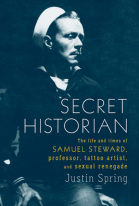 2010 also saw the publication of four (auto)biographical works on tattooing. The first focused on the extraordinarily diverse life of one of the authors of a major study of tattooing and his passage from published academic into the world of sex research and running a tattoo shop, Justin Spring’s Secret Historian: The life and times of Samuel Steward, Professor, Tattoo Artist, and Sexual Renegade. Steward is unique among tattooists in that he left a substantial body of personal papers ranging from unpublished memoirs, journalism, fiction, and artwork, to letters in archival collections and with his executor in San Francisco, which have been extensively drawn upon to create this in-depth account.
2010 also saw the publication of four (auto)biographical works on tattooing. The first focused on the extraordinarily diverse life of one of the authors of a major study of tattooing and his passage from published academic into the world of sex research and running a tattoo shop, Justin Spring’s Secret Historian: The life and times of Samuel Steward, Professor, Tattoo Artist, and Sexual Renegade. Steward is unique among tattooists in that he left a substantial body of personal papers ranging from unpublished memoirs, journalism, fiction, and artwork, to letters in archival collections and with his executor in San Francisco, which have been extensively drawn upon to create this in-depth account.
The second is another book from Kat von D, who in The Tattoo Chronicles shares a year of multiple changes and personal growth from May 2008 to late June 2009 through the lens of diary entries on her work with an array of individual clients, with full-page color photographs of the designs created for them interwoven with text.
Awareness of the need to act to retrieve the past of the American tattoo profession at the local level provided the stimulus for the third title, These Old Blue Arms: The Life and Work of Amund Dietzel. Written by Milwaukee tattooist Jon Reiter, its foreword notes that “As is so often the case with traditions that evolve on the periphery of mainstream culture, tattooing in America has suffered from the vagaries of local history.” (Reiter 2010: 1) The first sections cover Dietzel’s childhood in Norway in the 1890s and work as a sailor in the merchant fleet (where he did his first tattooing) through his immigration to the United States in 1907, his ten-year career travelling with carnivals prior to the first World War his eventual settlement in Milwaukee, and achievement of an international reputation as a quality tattoo artist. Much of the book is devoted to color reproductions of Dietzel’s artwork presented in relative chronological order, and the author provides a lengthy explanation of the origin of the trade term flash:
The term “flash” is rooted in the carnival trade, dating back to before the dawn of the 19th century. In a carnival or circus setting. A “well flashed” front or concession indicated that a booth, or stand, was eye-catching and well presented … In the carnival world, flash was everything-drawing in a passerby like a moth to a flame. With all of the sights and sounds of the carnival competing for attention, one had to stand out from the rest if any money wad to be made. (Reiter 2010: 38)
The inclusion of family photographs and documents makes These Old Blue Arms an example of the type of historical writing that is needed to reweave tattooing into the past of more mainstream America. Dietzel died on February 9, 1974.
The fourth biographical work is a documentary film about the life of a prominent California tattoo artists, Ed Hardy: Tattoo the World. It is framed as an ongoing reminiscence with the artist and begins with his interest in tattooing at age ten, then explores the evolution of his interest in different forms of contemporary art during his years at the San Francisco Art Institute, his the rejection of a scholarship to Yale, through his involvement with combining tattoo art with printmaking, painting, publishing, and writing, and the global impact of his designs through their use in contexts as varied as the fashion and entertainment industries.
Three years after the release of this documentary Don Ed Hardy added his life story to the pool of autobiographies of tattoo artists himself with Wear Your Dreams: My Life in Tattoos. The title is taken from the slogan he used on his business cards. The book is richly detailed and traces his evolution as a tattooist, his encounters with significant figures in tattoo history ranging from Phil Sparrow (Samuel Steward) and Sailor Jerry Collins to the Japanese hori masters, and the birth of what would become known as “the new tribalism.” He also notes the complex social norms of the international network of tattooists scattered across the globe in the age before the Internet eased communication.
2013 also saw the publication of Kat von D’s third book, Go Big or Go Home: Taking Risks in Life, Love, and Tattooing. This collection is focuses on large-scale tattoos, themed with issues important to the author—individuality, strength, creativity, independence, presence, wisdom, and altruism, with each section illustrated by photographs of some of her clientele.
And the most thorough documentary attempt at telling the story of the intersection of the different streams of tattooing that combined to birth the contemporary renaissance of tattoo art as a mainstream phenomenon, Tattoo Nation: The True Story of the Ink Revolution, was completed in 2013. The film centers around the careers of Charlie Cartwright, Jack Rudy, Ed Hardy, and Freddy Negrete, and features lengthy interviews with them (and others who worked with them) along with historical footage of the early tattoo conventions. The central question the film attempts to answer is stated in the abstract on its case: “How did tattoo go from something that was put on you to an expression that comes from within you?”
The 2015 publication of the beautifully detailed overview of the career of San Francisco tattoo artist Vernon Ingemarson (1919-1988), Sailor Vern, is similar in some ways to the treatment given Amund Dietzel in These Old Blue Arms; as a historical retrieval of a significant figure in the history of North American tattooing. By the time of his death Ingemarson had amassed a large collection of flash, rubbings, photos and acetate sheets spanning his time as a tattooist, from his early training in Norfolk in the 1940s to his own shop in San Francisco, and his reconnection with the tattooing community of artists in 1977. After his death, the collection was kept intact by subsequent owners and forms the basis of the body of this book. In addition to his artwork, he also designed a distinctive tattoo machine that could be easily assembled and maintained. Sailor Vern opens with sections on his early life in Montana, Colorado and California, his entry to the tattooing profession and work in Virginia, San Francisco, and Guam, then moves to illustrate in depth his flash art from the 1940s and 1950s through the last decade of his life. An unusual inclusion are samples of his work as a painter and his acetate sheets of designs (a format not often preserved) as well as trade catalogs, letters, and sketches.
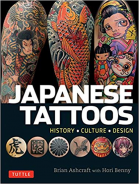 2016 was a rich year for publications on tattoos and the cultures that used them. The classic Japanese craft of irezumi is beautifully and thoroughly presented in Brian Ashcraft and Hori Benny’s heavily illustrated Japanese Tattoos: History, Culture, Design from Tuttle Publishing. The introduction provides a clear summary of the various stages of the history of tattooing in Japan since the beginning of the nation’s recorded chronicles (as both a free choice and a legal penalty) and its changing influence on modern tattoo culture. Separate chapters present in detail kanji tattoos (using words and phrases written in Japanese characters), tattoos using images drawn from the natural world (ranging from flowers and cherry blossoms to pine trees, water, wind, clouds and fire), real and mythical creatures (including the phoenix, tigers, lucky cats, guardian dogs, cranes, and butterflies as well as the familiar three-clawed dragon), supernatural beings, eight types of bodysuit tattoos, and contemporary irezumi designs. Interviews with tattoo artists and their clientele are included in each chapter.
2016 was a rich year for publications on tattoos and the cultures that used them. The classic Japanese craft of irezumi is beautifully and thoroughly presented in Brian Ashcraft and Hori Benny’s heavily illustrated Japanese Tattoos: History, Culture, Design from Tuttle Publishing. The introduction provides a clear summary of the various stages of the history of tattooing in Japan since the beginning of the nation’s recorded chronicles (as both a free choice and a legal penalty) and its changing influence on modern tattoo culture. Separate chapters present in detail kanji tattoos (using words and phrases written in Japanese characters), tattoos using images drawn from the natural world (ranging from flowers and cherry blossoms to pine trees, water, wind, clouds and fire), real and mythical creatures (including the phoenix, tigers, lucky cats, guardian dogs, cranes, and butterflies as well as the familiar three-clawed dragon), supernatural beings, eight types of bodysuit tattoos, and contemporary irezumi designs. Interviews with tattoo artists and their clientele are included in each chapter.
The value of chronologically and collectively examining the constellation of original artwork produced across the decades by individual tattooists to illuminate trends and changes in both technology and themes is shown in the second 2016 volume,Vintage tattoo flash: 100 years of traditional tattoos from the collection of Jonathan Shaw covers the first 75 years of tattooing in America from the 1900s to the 1970s through three hundred sheets of unpublished flash from the massive personal collection assembled by veteran tattooist Jonathan Shaw. Artists represented range from unknown craftsmen to more familiar names such as Bert Grimm, Sailor Jerry, Paul Rogers and the Moskowitz brothers. In the “Author’s Note”, he shares the call tattoos have always held for him:
I grew up by the sea, dreaming of far off lands. One of my earliest childhood memories is standing on tiptoe, squinting into an old tattoo parlor window, lost in a world I’d always known existed in some foggy, lost memory zone of forever. Every inch of wall was covered with haunting little designs, calling to a kid’s fancy from that mysterious, smoky world within. I can still smell the dust on that old window ledge; still see the frozen, nicotine-stained image of a skinny old man with blurry, blue-green sailor arms hunched over another man. I can still hear the otherworldly call of a weird buzzing contraption digging into skin, as if searching for secrets of the soul.
Looking in there, that kid was called to follow a path, leading him into a world of exotic blood rituals as old as time. On that day, the benevolent spirits of the tattoo were conjured up behind my eyes. Nobody had ever told me about tattooing, but, standing there, eyes wide in deep, childlike wonder and unconscious recognition, I knew I wanted one. I wanted to travel to wherever sailors sailed to, far away over a tattoo sailing ship’s faded watercolor horizon, as far as the spirit could fly on blurry old blue-green tattooed wings, to a place with yellowed palm trees, and a crooked old tattooed banner that reads “ Homeward Bound.” (Shaw 2016: 65)
Paralleling Shaw’s work, the next 2016 volume addresses the phenomenon of contemporary tattoo art in all its international diversity. Ink:The Art of Tattoo by Victor Cheung and Kevin Wong is a collection of 700 original and classic flash from 43 artists working in Finland, the United States (Chicago and New York City), the Philippines, Indonesia, Hong Kong, Argentina, France, Brazil, Ecuador, the Netherlands, Poland, Spain, Mexico, Australia, Japan, Russia, Venezuela, and the United Kingdom. The second section of the book, “Tatt Snaps” presents the work of ten visual artists integrating tattoos with photography, followed by “Tatt Talk” with profiles and interviews of artists from Russia, Japan, Poland, France, China and Singapore. Biographical notes on each of the artists are included on the final pages.
While the Internet has made possible the global sharing of tattoo art and discussions about it, the final 2016 volume approaches the two subjects as complementary. The twenty chapters of the interdisciplinary anthology The Tattoo Project: Commemorative Tattoos, Visual Culture, and the Digital Archive, edited by sociologist Deborah Davidson of York University and published in Toronto by Canadian Scholars, consider an aspect of tattooing not usually treated in depth. As defined here, “commemorative tattoos… maybe in memory or honour of a living or deceased person or animal; of a place relationship, life event or transition; of something accomplished, worked at or for, still to be achieved, or yet to be dreamed.” (Davidson 2016: 6.) The book is rooted in the construction of a digital archive of contributed tattoo stories and photos, and is divided into four sections covering the methods and theories used (and the approaches to tattooing taken by culture and history), the illustration of commemorative tattoos through poetry and photographs, seven personal narratives/case studies sharing the significance of commemoration by tattoos, and discussion of “The Tattoo Project: A Community Under Construction” at the intersection of the ideas of archives, public sociology, technology and community. The Tattoo Project homepage is at http://thetattooproject.info/about.html.
In 2017, Jonathan Shaw drew on his private collection of historic tattoo art again to create Vintage Tattoo Flash. Volume II: 100 Years of Traditional Tattoos from the collection of Jonathan Shaw covering the period from the 1920s to the 1970s with over 200 further unpublished examples of flash art created by American tattooists.
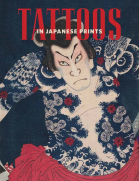 Another 2017 work is an exhibition catalog vividly illustrating the presence of tattoos in the medium of nineteenth-century wood-block printing. Tattoos in Japanese Prints was published in Boston by the Museum of Fine Arts and edited by Sarah Thompson, the curator of Japanese art. Over 100 prints are shown, and Thompson’s lengthy introductory essay “Edo Ink: Under the Skin “provides detailed context for the use of tattoo in portrayals of scenes as varied as an intimate moment between lovers, action from the kabuki stage, and craftsmen raising a house ridgepole.
Another 2017 work is an exhibition catalog vividly illustrating the presence of tattoos in the medium of nineteenth-century wood-block printing. Tattoos in Japanese Prints was published in Boston by the Museum of Fine Arts and edited by Sarah Thompson, the curator of Japanese art. Over 100 prints are shown, and Thompson’s lengthy introductory essay “Edo Ink: Under the Skin “provides detailed context for the use of tattoo in portrayals of scenes as varied as an intimate moment between lovers, action from the kabuki stage, and craftsmen raising a house ridgepole.
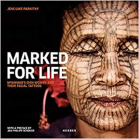 The third volume from 2017, Marked For Llife: Myanmar’s Chin women and Their Facial Tattoos harkens back to Michael King’s 1972 Moko: Maori Tattooing in the 20th Century. Based upon the portraits collected by photographer Jens Uwe Parkitny among women in the Chin state of northwest Myanmar since the beginning of his research in 2001, the book reflects the contents of an exhibition that opened in Yangon on March 28, 2016. The core of the book demonstrates how the exhibition combined images from Parkitny’s corpus of work with textiles, jewelry and extant records to colorfully illustrate the range and complexity of tattooing as conducted among the Chin. Although the practice had been banned by the government, Parkitny foresees a revival analogous to the rebirth of facial tattooing among the women of the Maori, the Inuit, and Native Americans. Readers will also find the essay by Lars Krutak of the National Museum of Natural history at the Smithsonian Institution, “The Visual Language of Facial Tattooing” useful for its perspective on the treatment of tattooing in the literatures of art and anthropology.
The third volume from 2017, Marked For Llife: Myanmar’s Chin women and Their Facial Tattoos harkens back to Michael King’s 1972 Moko: Maori Tattooing in the 20th Century. Based upon the portraits collected by photographer Jens Uwe Parkitny among women in the Chin state of northwest Myanmar since the beginning of his research in 2001, the book reflects the contents of an exhibition that opened in Yangon on March 28, 2016. The core of the book demonstrates how the exhibition combined images from Parkitny’s corpus of work with textiles, jewelry and extant records to colorfully illustrate the range and complexity of tattooing as conducted among the Chin. Although the practice had been banned by the government, Parkitny foresees a revival analogous to the rebirth of facial tattooing among the women of the Maori, the Inuit, and Native Americans. Readers will also find the essay by Lars Krutak of the National Museum of Natural history at the Smithsonian Institution, “The Visual Language of Facial Tattooing” useful for its perspective on the treatment of tattooing in the literatures of art and anthropology.
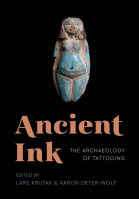 The next work to appear in 2017 addresses their presence in the archaeological record and how it can be interpreted. The anthology Ancient Ink: The archaeology of tattooing, edited by Lars F. Krutak of the Smithsonian Institution and Aaron Deter-Wolf from the University of Washington Press, is divided into three sections: Skin, Tools and Art. The first examines “topics related to naturally and deliberately preserved tattooed human remains … the most spectacular and direct form of archaeological evidence of tattooing in ancient and historic societies,” made possible by modern imaging technology that can expose tattoos on museum specimens (Krutak and Deter-Wolf 2017: 4). The first seven papers discuss evidence as varied as mummies from Egypt and Nubia, Ibaloy tattoos from the Philippines (a tradition being revived), the Iron Age Pazyryk culture of Siberia (originally described in English in 1970 by Sergei Rudenko in Frozen Tombs of Siberia: The Pazyryk Burials of Iron Age Horsemen), and a collection of nineteenth-century European tattooed skins acquired by the Wellcome Collection in London in 1929. The deliberate preservation of this type of material is addressed by the editors in the eighth chapter, “After You Die: Preserving Tattooed Skin,” including a profile of the Foundation for the Art and Science of Tattooing, founded in 2014 by Dutch illustrator and tattoo artist Peter van der Helm.
The next work to appear in 2017 addresses their presence in the archaeological record and how it can be interpreted. The anthology Ancient Ink: The archaeology of tattooing, edited by Lars F. Krutak of the Smithsonian Institution and Aaron Deter-Wolf from the University of Washington Press, is divided into three sections: Skin, Tools and Art. The first examines “topics related to naturally and deliberately preserved tattooed human remains … the most spectacular and direct form of archaeological evidence of tattooing in ancient and historic societies,” made possible by modern imaging technology that can expose tattoos on museum specimens (Krutak and Deter-Wolf 2017: 4). The first seven papers discuss evidence as varied as mummies from Egypt and Nubia, Ibaloy tattoos from the Philippines (a tradition being revived), the Iron Age Pazyryk culture of Siberia (originally described in English in 1970 by Sergei Rudenko in Frozen Tombs of Siberia: The Pazyryk Burials of Iron Age Horsemen), and a collection of nineteenth-century European tattooed skins acquired by the Wellcome Collection in London in 1929. The deliberate preservation of this type of material is addressed by the editors in the eighth chapter, “After You Die: Preserving Tattooed Skin,” including a profile of the Foundation for the Art and Science of Tattooing, founded in 2014 by Dutch illustrator and tattoo artist Peter van der Helm.
The second section, “Tools,” addresses how tattooing implements are identified in the archaeological record, how they are distinguished from other artifacts of similar form, and how they relate to cultural development, migration, and change. Subjects covered in these eight papers include an island-by-island examination of indigenous tattooing in Oceania, evidence for tattooing in southeastern Europe in both the Copper Age (ca. 6000 BCE) and the regional ethnographic record, identifying Native American tattoo tools from the Eastern Woodlands (and the significance of the revival of tattoos in Native communities in Canada and the eastern United States), tattoos among the Iron Age Sarmatian people of Eurasia, and the development of use-wear analysis as a means of identifying tattooing technology in archaeological and museum collections. The final section on “Art” is the shortest and examines anthropomorphic and possibly tattooed figures in European prehistory from the Upper Paleolithic (50,000-10,000 BCE) through the Bronze Age (2300-1200 BCE) as a potential genre of artifacts illustrating the presence and changes in tattooing across these millennia, prehistoric tattooed ivory figurines from the maritime culture of the Bering Strait, and the rebirth of indigenous tattooing as a cultural practice in contemporary Alaska.
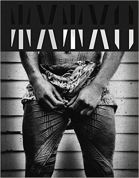 While tattooing as practiced in Tahiti and the Marquesas has long been represented in the literature on Polynesia, the rich and ancient tradition of Samoan tatau received in-depth coverage in the richly illustrated 2018 work Tatau: A History of Samoan Tattooing by Sean Mallon and Sebastien Galliot. With a time depth of 3,000 years (beginning with the pottery designs of the Lapita culture in 1500 BCE), the book begins with a look at the origin stories of tatau and the connections they establish for Samoa with the broader Pacific world. The second section covers the history of Samoan tattooing from 1722 to 1900 and draws on both Samoan and European sources (these latter often missionaries, explorers, or officials of the German colonial administration from 1899-1914.) During the colonial era, exhibiting living examples from the population of the colonies in the home country was popular in the major cities of Europe, and several groups of Samoans were brought to Germany and Belgium between 1889 and 1914. German ethnologists also visited Samoa and recorded the designs and imagery used in tatau in detail. In the third section, “Tatau: Persistence and Change, 1900-2000,” factors as diverse as the shift from German to New Zealand colonial rule, World War II, the spread of tatau through the Samoan diaspora, and the Samoan nationalist movement are mirrored in a detailed discussion of the persistence of traditional tatau designs and the creation of new ones for specific groups, notably the members of Peace Corps Samoa. The fourth chapter on “Tatau as a Ritual Institution, 2000-2010” outlines the traditional forms of address for the tufuga ta tatau, their clan lineages, the formal steps to be followed in acquiring tatau, its social significances and the specific terms of iconography for the elements of designs worn by men and women. The final section examines “Tatau and Its Globalization, 2010-2017,” touching on the roles being played by non-Samoans within the spread of tatau and the active outreach made by Samoan tufuga as part of a wider community of tattooists and their craft.
While tattooing as practiced in Tahiti and the Marquesas has long been represented in the literature on Polynesia, the rich and ancient tradition of Samoan tatau received in-depth coverage in the richly illustrated 2018 work Tatau: A History of Samoan Tattooing by Sean Mallon and Sebastien Galliot. With a time depth of 3,000 years (beginning with the pottery designs of the Lapita culture in 1500 BCE), the book begins with a look at the origin stories of tatau and the connections they establish for Samoa with the broader Pacific world. The second section covers the history of Samoan tattooing from 1722 to 1900 and draws on both Samoan and European sources (these latter often missionaries, explorers, or officials of the German colonial administration from 1899-1914.) During the colonial era, exhibiting living examples from the population of the colonies in the home country was popular in the major cities of Europe, and several groups of Samoans were brought to Germany and Belgium between 1889 and 1914. German ethnologists also visited Samoa and recorded the designs and imagery used in tatau in detail. In the third section, “Tatau: Persistence and Change, 1900-2000,” factors as diverse as the shift from German to New Zealand colonial rule, World War II, the spread of tatau through the Samoan diaspora, and the Samoan nationalist movement are mirrored in a detailed discussion of the persistence of traditional tatau designs and the creation of new ones for specific groups, notably the members of Peace Corps Samoa. The fourth chapter on “Tatau as a Ritual Institution, 2000-2010” outlines the traditional forms of address for the tufuga ta tatau, their clan lineages, the formal steps to be followed in acquiring tatau, its social significances and the specific terms of iconography for the elements of designs worn by men and women. The final section examines “Tatau and Its Globalization, 2010-2017,” touching on the roles being played by non-Samoans within the spread of tatau and the active outreach made by Samoan tufuga as part of a wider community of tattooists and their craft.
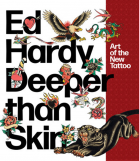 The transformative journey of contemporary tattooing from a marginal craft to a recognized and accepted part of the world of graphic arts and design was clearly shown in the most recent volume, Ed Hardy: Deeper Than Skin, assembled to accompany a 2019 retrospective exhibition at the de Young Memorial Museum in San Francisco. Hardy’s work to reinvigorate tattooing as an art form over several decades is shown through 300 objects documenting his work in prints, drawings and three-dimensional pieces as well as his tattoo designs and flash art. His role in the renaissance of tattooing, connections to East Asian art, and his formal training as an artist are discussed to interpret his impact. Whether crafted in a tattoo shop under the Chicago “L” tracks, in a traditional setting with ritual significance by the Pacific, or assembled in museum collections and exhibitions of original flash art, the complex history of tattoos will remain a subject of fascination with its own distinctive genre of books and online publications to a world which has recognized and affirmed the value of the individuality each mark bears.
The transformative journey of contemporary tattooing from a marginal craft to a recognized and accepted part of the world of graphic arts and design was clearly shown in the most recent volume, Ed Hardy: Deeper Than Skin, assembled to accompany a 2019 retrospective exhibition at the de Young Memorial Museum in San Francisco. Hardy’s work to reinvigorate tattooing as an art form over several decades is shown through 300 objects documenting his work in prints, drawings and three-dimensional pieces as well as his tattoo designs and flash art. His role in the renaissance of tattooing, connections to East Asian art, and his formal training as an artist are discussed to interpret his impact. Whether crafted in a tattoo shop under the Chicago “L” tracks, in a traditional setting with ritual significance by the Pacific, or assembled in museum collections and exhibitions of original flash art, the complex history of tattoos will remain a subject of fascination with its own distinctive genre of books and online publications to a world which has recognized and affirmed the value of the individuality each mark bears.
References
Arlen, Harold. Lydia the Tattooed Lady. New York: Leo Feist Inc., 1939.
Ashcraft, Brian, and Hori Benny. Japanese Tattoos: History, Culture, Design. Tokyo: Tuttle Publishing, 2016.
At the Circus. Directed by Edward Buzzell. Hollywood, Calif.: Metro-Goldwyn-Mayer, 1939.
Atkinson, Michael. Tattooed: The Sociogenesis of a Body Art. Toronto: University of Toronto Press, 2003.
Burchett, George. Memoirs of a Tattooist, from the Notes, Diaries, and Letters of the Late “ing of Tattooists.” London: Oldbourne, 1958. []
Caplan, Jane, ed. Written on the Body: The Tattoo in European and American History. Princeton, N.J.: Princeton University Press, 2000.
Cheung, Victor, and Kevin Wong. Ink: The Art of Tattoo. Hong Kong: viction:workshop ltd, 2016.
Collins, Jerry. Sailor Jerry Collins, American Tattoo Master: In His Own Words. Honolulu: Hardy Marks Publications, 1994. (reprinted in 2005 and 2007.)
Davidson, Deborah, ed. The Tattoo Project: Commemorative Tattoos, Visual Culture, and the Digital Archive. Toronto: Canadian Scholars’ Press, 2016.
DeMello, Margo. Bodies of Inscription: A Cultural History of the Modern Tattoo Community. Durham, N.C.: Duke University Press, 2000.
DeMello, Margo. Encyclopedia of Body Adornment. Westport, Conn.: Greenwood Press, 2007.
Ebensten, Hanns. Pierced Hearts and True Love: An Illustrated History of the Origin and Development of European Tattooing and a Survey of Its Present State. London: Verschoyle, 1953.
Ed Hardy: Deeper Than Skin. San Francisco: Fine Arts Museums of San Francisco in association with Rizzoli Electa, 2019.
Ed Hardy: Tattoo the World. Directed by Emiko Omori. New York: New Video Group, 2010.
Facts relating to Miss Irene Woodward, the Only Tattooed Lady: Being a Full and Complete Account of the Life and Adventures of This Young Lady … Together with Many Extracts from the Metropolitan Press in Reference to Her, All Clearly Proving Her to Be One of the Most Remarkable and Rarest Curiosities Now on Exhibition. New York: New York Popular Publishing Company, 1886.
Fellowes, C.H. The Tattoo Book. Princeton: Pyne Press, 1971.
Fletcher, Robert. Tattooing Among Civilized People: Read before the Anthropological Society of Washington, December 19, 1882. Washington, D.C.: Judd & Detweiler,1883. https://archive.org/details/39002011128262.med.yale.edu/page/n5.
Hambly, Wilfrid. The History of Tattooing and Its Significance: with some account of other forms of corporal marking. London: H.F. & G. Witherby, 1925. Reprint ed. Mineola, N.Y.: Dover Publications, 2009.
Handy, Willowdean Chatterson. Tattooing in the Marquesas. Honolulu: Bishop Museum, 1922. https://archive.org/details/tattooinginmarq00handgoog.
Hardy, Don Ed, with Joel Selvin. Wear Your Dreams: My Life in Tattoos. New York: Thomas Dunne Books, 2013.
Ingemarson, Vernon Franc, et. al. Sailor Vern. Colorado Springs, Colo.: Yellow Beak Press,2015.
Johnson, Jeff. Tattoo Machine: Tall Tales, True Stories, and My Life in Ink. New York: Spiegel & Grau, 2009.
King, Michael. Moko: Maori Tattooing in the 20th Century. Wellington: Alister Taylor, 1972. Reprint ed. Auckland: David Bateman, 2008.
Konstantinus, Djordgi. The True Life and Adventures of Captain Costentenus, the Tattooed Greek Prince. New York: New York Popular Publishing Company, 1881. http://nrs.harvard.edu/urn-3:FHCL.HOUGH:34849929.
Krutak, Lars F., and Aaron Deter-Wolf, eds. Ancient Ink: The Archaeology of Tattooing. Seattle: University of Washington Press, 2017.
Mallon, Sean, and Sébastien Galliot. Tatau: A Cultural History of Samoan Tattooing. Honolulu: University of Hawai’i Press, 2018.
Miller, Jean-Chris, The Body Art Book: A Complete, Illustrated Guide to Tattoos, Piercings, and Other Body Modifications. New York: Berkley Books, 1997.
Morita, Ichira. Irezumi: Japanese Tattooing. Tokyo: Zuhushinsha, 1966.
Parkitny, Jens Uwe. Marked for Life: Myanmar’s Chin Women and Their Facial Tattoos. Bielefeld: Christof Kerber, 2017.
Parry, Albert. Tattoo: Secrets of A Strange Art as Practised Among the Natives of the United States. New York: Simon and Schuster, 1933. Reprint ed. Mineola, N.Y.: Dover Publications, 2006.
Pitts-Taylor, Victoria. In the Flesh: The Cultural Politics of Body Modification. New York: Palgrave Macmillan, 2003.
Reiter, Jon. These Old Blue Arms: The Life and Work of Amund Dietzel. Milwaukee: Solid State Publishing Company, 2010.
Robley, Horatio Gordon. Moko, or Maori Tattooing. London: Chapman and Hall, 1896. https://hdl.handle.net/2027/njp.32101068189883.
Rudenko, Sergei Ivanovich. Frozen Tombs of Siberia: The Pazyryk Burials of Iron Age Horsemen. Berkeley, Calif.: University of California Press, 1970.
Sanders, Clinton R. Customizing the Body: The Art and Culture of Tattooing. 2nd ed. Philadelphia: Temple University Press, 2008 (1st ed. 1989).
Schiffmacher, Henk. Encyclopedia for the Art and History of Tattooing. Amsterdam: Carerra, 2010.
Scutt, Ronald W. B., and Christopher Gotch. Skin Deep: The Mystery of Tattooing. London: Peter Davies, 1974.
Shaw, Jonathan. Vintage Tattoo Flash. Volume II: 100 Years of Traditional Tattoos from the collection of Jonathan Shaw. New York: PowerHouse Books. 2017
Shaw, Jonathan. Vintage Tattoo Flash: 100 Years of Traditional Tattoos from the Collection of Jonathan Shaw. New York: PowerHouse Books, 2016.
Simmons, D. R. Ta Moko: The Art of Maori Tattoo. Auckland: Reed Methuen, 1986.
Sparks, Robert. Polynesian Tattooing: The Techniques, Iconography, Patronage, Profession, and Esthetics. MA thesis, University of Hawai’i, 1965. http://hdl.handle.net/10125/36035.
Spring, Justin. Secret Historian: The Life and Times of Samuel Steward, Professor, Tattoo Artist, and Sexual Renegade. New York: Farrar, Straus and Giroux, 2010.
Steward, Samuel M. Bad Boys and Tough Tattoos: A Social History of the Tattoo with Gangs, Sailors, and Street-corner Punks, 1950-1965. New York: Haworth Press, 1990.
Swan, James G. The Haidah Indians of the Queen Charlotte’s Islands, British Columbia: With a Brief Description of Their Carvings, Tattoo Designs, etc. Washington, D.C.: Smithsonian Institution, 1874. http://www.canadiana.ca/view/oocihm.23957.
“Tattoo” in Oxford English Dictionary. https://www.oed.com/view/Entry/198122?rskey=SHI9d5&result=2&isAdvanced=false#eid. Accessed 9 January 2020.
Tattoo Nation: The True Story of the Ink Revolution. Directed by Eric Schwartz. Denver: Visions Verité, 2013.
Tattootime. Forked River, N.J.: Permanent Press, 1982-1988.
Thomas, Nicholas, Anna Cole, and Bronwen Douglas, eds. Tattoo: Bodies, Art, and Exchange in the Pacific and the West. Durham, N.C.: Duke University Press, 2005.
Thompson, Sarah E., ed. Tattoos in Japanese Prints. Boston: Museum of Fine Arts, 2017.
Von D, Kat, High Voltage Tattoo. New York: Collins Design, 2009.
Von D, Kat. Go Big or Go Home: Taking Risks in Life, Love, and Tattooing. New York: HarperCollins, 2013.
Von D, Kat. The Tattoo Chronicles. New York, NY: Collins Design, 2010.
Copyright R. Ridinger 2020

